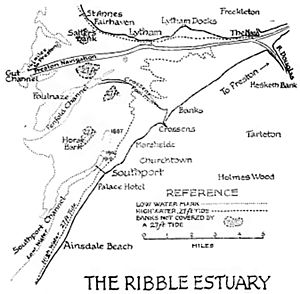Ribble and Alt Estuaries facts for kids
| Site of Special Scientific Interest | |
 |
|
| Area of Search | Merseyside and Lancashire |
|---|---|
| Coordinates | 53°43′N 2°58′W / 53.71°N 2.97°W |
| Interest | Biological |
| Area | 9226.3 hectares, 22,798.2 acres (92,261,000 m2) |
| Notification | 1966 (Southport Sanctuary) 1976 (Ribble Estuary) 1984 |
| Designated: | 28 November 1985 |
| Reference #: | 325 |
The Ribble and Alt Estuaries are special places where the Ribble and Alt rivers meet the Irish Sea. They are found on the coast of north-west England, in areas called Lancashire and Merseyside. These estuaries are very important for nature and are protected by different plans to keep them safe.
Contents
Why This Area Is Special
The Ribble and Alt Estuaries are home to many different kinds of birds. These birds, especially waders (birds that walk in shallow water) and wildfowl (like ducks and geese), use the estuaries to find food and to spend the winter. Because so many different birds gather here, the area has been given special protection.
Protected Status
The Ribble Estuary has been recognized as a Site of Special Scientific Interest (SSSI) since 1966. This means it's a place with important plants, animals, or geology. It is also part of Natural England's Ribble Estuary National Nature Reserve.
The estuaries are also known as a Special Protection Area and a Ramsar site.
- A Special Protection Area is a place protected for rare or vulnerable birds.
- A Ramsar site is a wetland of international importance, especially for waterbirds. These protections help make sure the birds have a safe place to live and feed.
What the Estuary Looks Like
The Ribble Marshes National Nature Reserve covers about 2,302 hectares (5,688 acres). It sits in the middle of the larger Site of Special Scientific Interest (SSSI), which is about 9,226 hectares (22,798 acres) in size.
Habitats and Features
The area has large parts of sandy and muddy flats that are covered and uncovered by the tide. There are also wide areas of saltmarsh.
- Mudflats are full of tiny creatures that birds love to eat.
- Saltmarshes are grassy areas that grow in salty water. Here, you'll find plants like saltmarsh grass and red fescue. Closer to the sea, you might see cord-grass.
The Ramsar wetlands are even bigger, covering about 13,464 hectares (33,270 acres). This area also includes sand dunes. These dunes have interesting plants and are home to important groups of amphibians, like frogs and toads. The entire site is incredibly important for the huge numbers of waterbirds that spend their winters here.
Amazing Birds of the Estuary
The Ribble and Alt Estuaries are a birdwatcher's paradise! Many different bird species visit or live here.
Birds That Breed Here
Some birds choose this special place to lay their eggs and raise their young. These include:
- Common tern (Sterna hirundo)
- Lesser black-backed gull (Larus fuscus)
- Ruff (Philomachus pugnax)
Migratory Visitors
Other birds stop by during their long journeys in spring and autumn. They use the estuaries as a resting and feeding spot before continuing their travels. These include:
- Ringed plover (Charadrius hiaticula)
- Sanderling (Calidris alba)
Wintering Birds
Many birds travel from colder places to spend the winter at the estuaries, where they can find plenty of food. Some of these winter visitors are:
- Bar-tailed godwit (Limosa lapponica)
- Black-tailed godwit (Limosa limosa islandica)
- Bewick's swan (Cygnus columbianus bewickii)
- Dunlin (Calidris alpina alpina)
- Golden plover (Pluvialis apricaria)
- Grey plover (Pluvialis squatarola)
- Knot (Calidris canutus)
- Oystercatcher (Haematopus ostralegus)
- Pink-footed goose (Anser brachyrhynchus)
- Pintail (Anas acuta)
- Redshank (Tringa totanus)
- Shelduck (Tadorna tadorna)
- Teal (Anas crecca)
- Whooper swan (Cygnus cygnus)
- Eurasian wigeon (Anas penelope)


